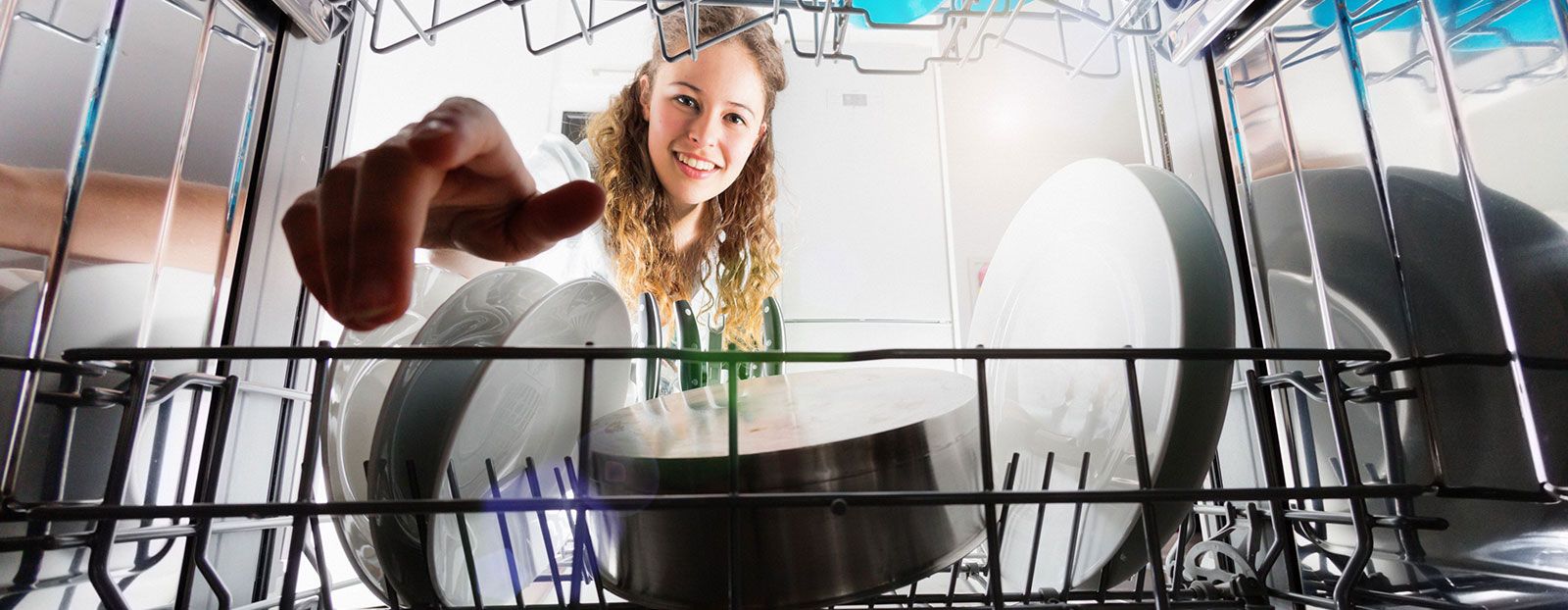Cleaning your dishwasher may seem counterintuitive; after all, you run it every day — shouldn’t it keep itself clean? Unfortunately, dishwashers are not self-cleaning. Each time you run your dishwasher, food scraps, soap scum, and mineral deposits build up on the inside, contaminating your clean dishes and resulting in a less efficient machine.
At Quality Plumbing of Gainesville, Inc., a Gainesville plumbing company, we know that the best way to keep your appliances up and running is to take good care of them. To keep your dishes clean and avoid any emergency plumbing repairs, follow these ten steps to clean your dishwasher.
Step One: Start From The Outside In
For stainless steel dishwashers, use a specialized cleaning product in order to avoid unsightly streaking on your dishwasher door. For other dishwashers, soap, water, and a clean sponge will suffice. You can use a clean toothbrush or cotton swab to clean knobs, buttons, and other hard-to reach areas.
Step Two: Remove And Scrub The Racks
Carefully remove the moveable parts inside your dishwasher, such as racks and silverware holders. These pieces can be cleaned in the sink with soap and water as you would pots and pans.
Step Three: Remove Food And Other Debris From The Machine Tub
Remember the food scraps and soap scum we mentioned earlier? These can collect in the tub area at the bottom of the machine. Remove any debris with a napkin or paper towel. According to Gainesville plumbers, this helps to improve drainage and also prevents any future damage to the machine.
Step Four: Scrub And Disinfect The Spray Arms
If you have a small dishwasher, you may only have one spray arm at the bottom of the machine, but larger dishwashers often feature a second spray arm on the top. These can be scrubbed clean with a stiff brush and soapy water. Next, dip the brush in vinegar and use it to remove any mineral deposits on the spray arms or water outlets. You can use a toothpick for any small orifices such as water outlets.
Step Five: Check The Food Trap
Does your dishwasher have a food trap or filter? Check your service manual for instructions on where to find it and how to clean it out. The service manual for your specific dishwasher model should be available online.
Tip: You can save time on this step by checking the food trap every time you empty your dishwasher.
Step Six: Clean The Rubber Seal
The rubber seal on the door and perimeter of your dishwasher is called a gasket. Scrub the gasket with hot, soapy water. You may notice mold starting to form around the gasket. If you do, mix a tablespoon of bleach and a half gallon of warm water to create a mild bleach solution. Scrub the mold with a stiff brush dipped in your bleach solution, then rinse with fresh water.
Step Seven: Return The Racks And Silverware Holders To Their Original Position
Get everything back into place before continuing cleaning.While the racks and silverware holders have already been cleaned once, they can benefit from an extra rinse cycle through the dishwasher to remove any hard-to-clean spots or lasting odors.
Step Eight: Clean Your Dishwasher With Vinegar
Measure out a cup of white vinegar and pour it into a dishwasher-safe container. Place the container on the top rack and run the machine through a full hot water cycle. The vinegar removes grease and removes any unpleasant odors that may be lingering in the machine.
You can also spritz the inside of your dishwasher with white vinegar in between washes to keep the machine (and your dishes!) smelling fresh.
Step Nine: Wipe Down The Inside Of Your Dishwasher
Wait a few minutes for your dishwasher to cool down so that you don’t burn yourself. Then wipe down the inside of your dishwasher with a clean, dry cloth to remove any stuck-on food or dirt.
Step 10: Run The Machine With Baking Soda
Finally, sprinkle a cup of baking soda over the bottom of your dishwasher, then run a short hot water cycle. This leaves your machine smelling fresh and clean, ready to tackle your dishes once again.
Optional: Clean With Bleach
Living in Gainesville, you may notice you have an ongoing problem with mold and mildew. You can combat this by running a full hot cycle with one-half to one cup of bleach. However, DO NOT use bleach on dishwashers with a stainless steel finish, as bleach can corrode stainless steel.
House maintenance experts suggest that you thoroughly clean your dishwasher about once a month. Cleaning your dishwasher is simple, and should take about thirty minutes, not including the run time for the machine. For clean dishes, you need to start with a clean dishwasher. If you notice that your dishwasher is acting up and a good cleaning isn’t doing the trick, Quality Plumbing of Gainesville, Inc. is here to help. Contact us to schedule plumbing services and keep all your appliances in good working order. We offer 24-hour plumbing services and repairs.
